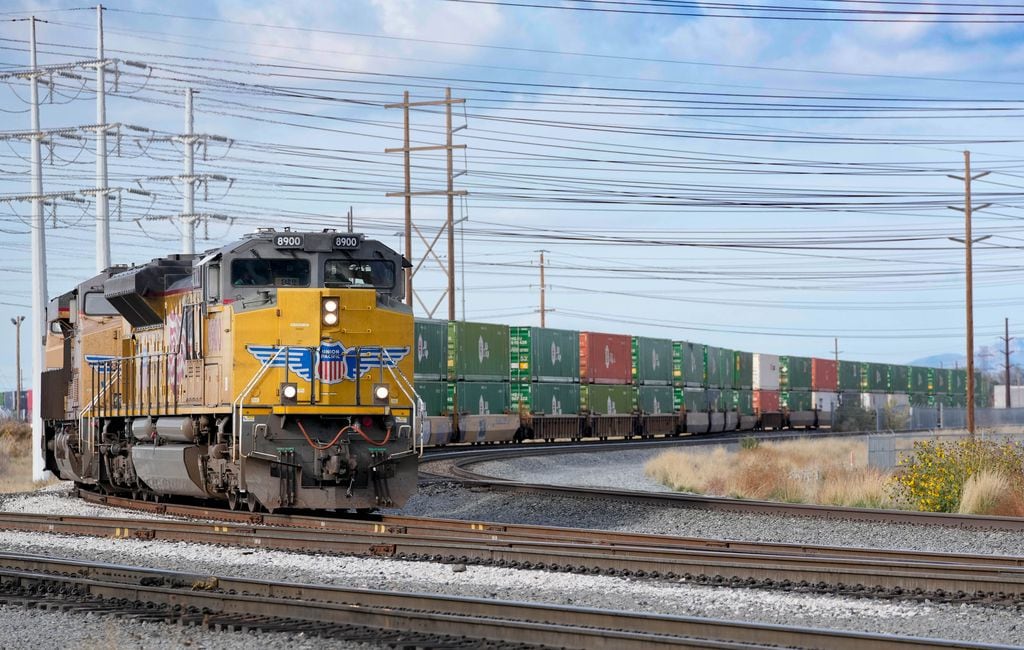The Utah Inland Port Authority’s new leadership has placed plans for a transloading facility on pause. And a study commissioned by port opponents found the agency may have dodged an expensive boondoggle.
The multimillion-dollar project was often touted by the authority’s previous executive director, Jack Hedge, as the port’s economic heart. The facility would have moved cargo from trains to trucks and vice versa, pulling in international cargo from West Coast partners. But members of the Stop the Polluting Port Coalition have questioned how Utah lawmakers and port officials could justify such a massive investment, which Hedge once projected to cost more than $50 million.
The coalition recently tapped Robert Leachman, a professor of industrial engineering and operations research at the University of California, Berkeley, to evaluate the port authority’s business plan. In a white paper released Tuesday, Leachman concluded a rail import-export hub in Utah doesn’t make much sense.
“I’m afraid the backers will have a very tough time trying to find a market for this facility,” Leachman said at a virtual news conference. “I just don’t think it’s there.”
Utah’s imports and exports
Shipping logistics are complicated, but in a nutshell, Utah doesn’t have enough people living nearby to justify a massive rail-to-road operation, he said. There is a reason seaports are located near megacities like Los Angeles and Oakland, and successful inland ports are located in urban centers like Chicago and Kansas City.
The stuff the U.S. imports these days is almost entirely retail goods like furniture, toys and electronics. It doesn’t import many raw materials for manufacturing anymore.
And the typical shipping container arriving from Asia was loaded at a single factory, Leachman said, “and therefore contains a very narrow range of goods that one factory makes.”
A shipping container contains way too much of one specific item to sell in the limited numbers of stores in a small market like Utah or even the Intermountain West. That’s why companies move the containers from the ports to nearby transloading sites to repackage them with many things that, say, all the Home Depots or Walmarts would need for a short period of time in a specific region. Those mixed loads then move to regional distribution centers and get trucked out to local retail stores.
“If you do transloading further inland … you’re not able to pool the regional demand with the West Coast, and you’re losing the inventory benefits,” Leachman said. “And … transloading is not cheap.”
That’s because shipping containers are packed by hand and need to be unpacked by hand, making it labor-intensive.
Creating a rail hub for international exports might not make business sense for Utah, either.
Utah currently employs about 10,000 people in mining and 151,500 people in manufacturing. Services, however, account for nearly 1.4 million jobs in the state, and services can’t be exported.
“A taxpayer-funded investment in a government-run, rail transloading facility provides no value,” said Craig Wallentine, a coalition member and retired executive with DuPont with experience in supply chain management, “and no new employment opportunities to those working in health care, education, banking, finance or our fast-growing software companies.”
The goods that Utah does export, however, tend to be high-value items like aircraft and aerospace parts, medical equipment and essential oils, according to Leachman’s report. Those goods are usually shipped via air, not by train or boat.
Utah ‘tried this before and it didn’t work’
And Utah has experience grappling with how to support a major import-export center. The Freeport Center in Clearfield redeveloped from a World War II Naval supply hub to transloading facility in the 1960s.
“Freeport became a trans-loading center for virtually all major appliances manufactured in the United States and marketed on the West Coast,” Leachman wrote in his report, “as well as a trans-loading center for many of the American farm implement companies.”
But when manufacturing in the U.S. shifted overseas and big box retailers started managing their own supply chains, the Freeport Center saw its freight traffic and significance dwindle away. Managers there tried to revamp the center as a distribution point for Asian goods entering through West Coast ports, Leachman said.
“That effort failed for the same reasons this [transloading facility] wouldn’t work,” he said. “I’m kind of disappointed Utah leaders seem to have forgotten their own history. You tried this before and it didn’t work, so why do you think it’ll work now?”
And while past leadership at the Utah Inland Port pointed to the supply chain issues brought by the pandemic, and the need for more inland ports to alleviate bottlenecks, Leachman called that argument mostly bunk.
He said the shipping headaches caused by the pandemic can be traced back to two trends. First, Americans were stuck at home, bored, with movie theaters and travel shut down. So they bought a lot of stuff. Second, a lot of employees within the supply chain were getting sick and couldn’t show up for work.
“If you look at where the problems are,” Leachman said, “the problems are not at transloading facilities in Southern California, they’re at marine terminals and at the railroads … a transloading facility in Salt Lake doesn’t address either of those things.”
Taking a step back from transloading
The Utah Inland Port Authority has experienced a major leadership overhaul in recent months, with a new board taking over in the spring and a new executive director, Ben Hart, hired this summer. That team has since put major projects, like the transloading facility, on pause.
Hart and the board are also in the process of drafting a master plan to better guide port’s mission and priorities.
“If our planning efforts determine a transload facility is right for this market,” Hart said in a written statement, “there will be robust engagement with neighborhoods on the west side of Salt Lake County and the business community.”
The port authority is currently doling out millions each year to rent vacant land for the proposed transloading facility, under a no-bid contract Hart has so far been unable to cancel.
Moving forward, Hart said any projects of that size will require a vote by the board in a public meeting.
“Until then, we’re talking with all our stakeholders,” Hart said, “to ensure this master plan reflects what best suits Utah and its logistics needs.”
What should be done with the inland port instead?
Leachman’s white paper also offered an evaluation of what Utah policymakers could support in the inland port jurisdiction, which covers about 16,000 acres in Salt Lake City’s northwest quadrant, to better support the economy and curb emissions. It’s mostly what has already been popping up in the area — distribution warehouses.
“I don’t need to tell you people how rapidly growing the Salt Lake area is,” Leachman said.
“There are still some retailers where their distribution center for the Intermountain region is on the east side of the Front Range in Colorado,” Leachman said. “And then they’re trucking everything over the mountains to reach retail outlets in Utah.”
Having those centers closer to Wasatch Front consumers, however, could curtail the greenhouse gases causing climate change, but it is not clear how it would impact emissions leading to unhealthy levels of ozone and particulate pollution in the local airshed.
Still, Stop the Polluting Port Coalition members said the white paper validated many of their concerns, including that lawmakers oversold the inland port to the public, and rather than delivering on grand promises, the port authority has mostly squandered millions in public funds with little to show for it.
“With far too many unknowns, the risks of getting it wrong are too great,” said Katie Pappas, a founding member of the coalition. “… There should be a halt to this entire project.”



































